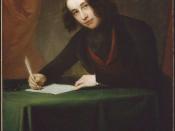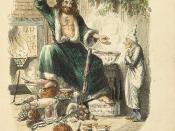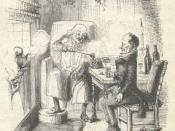The two stories, 'A Christmas Carol,' and 'Through the Tunnel,' contrast each other in different ways but are surprisingly similar in others. The fact that Dickens wrote in the Victorian times and Lessing produced a post 19th Century novel is reflected in their style of writing.
Dickens's father was constantly in debt, which caused the family to escape from people who they owed money. As a result, Dickens's father was sent to a debtors' prison when Dickens was at the age of twelve. What Dickens saw and heard during these terrible time remained a vivid memory that influenced Dickens to use in his writing. Dickens lived through the Industrial Revolution and attacked the economic system that was causing hardship and poverty. His concern for the poor, the orphaned and the unfortunate led him to write of certain situations in his books both didactically and for entertainment for the festive season.
Dickens's main techniques are using figurative language, complex sentences and polysyllabic words. For example, 'it was not in impenetrable shadow as the other objects in the yard were, but had a dismal light about it, like a bad lobster in a dark cellar.' From this quotation the adjective 'bad' links in with the adjective 'dark' that gives a sense of enchantment. In this case, Dickens is describing a 'bad lobster' (which is normally black) being locked away in a 'dark cellar' so that no one can find it. However, typically, the simile is so outlandish that is brings a smile to the reader.
'A Christmas Carol,' tells a story of Scrooge who is transported through Christmases of his past, present and those yet to come. Dickens creates a cold, dreary and to an extent frightening atmosphere by the use of pathetic fallacy, similes and metaphors in the first few chapters,


